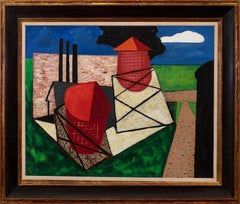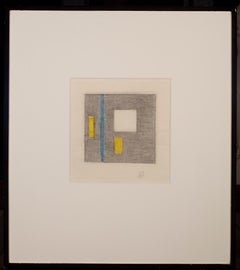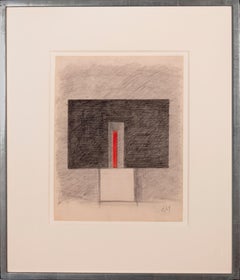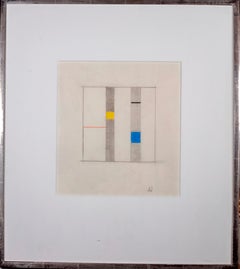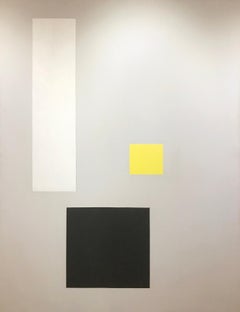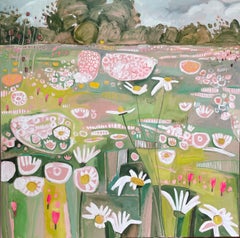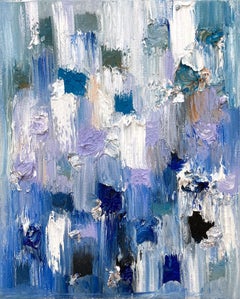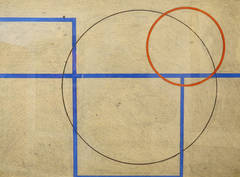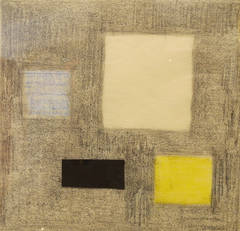Burgoyne Diller Art
to
7
4
2
1
Overall Width
to
Overall Height
to
14
1
1
2
5
10
10
3
1
11
11
10
8
3
14
7,786
4,999
2,504
1,372
12
14
Artist: Burgoyne Diller
"Industry" (Double Sided)
By Burgoyne Diller
Located in Lambertville, NJ
Jim's of Lambertville Fine Art Gallery is proud to present this piece by Burgoyne Diller (1906 – 1965).
Born in New York City in 1906, Burgoyne Diller began drawing when he was stri...
Category
1930s Burgoyne Diller Art
Materials
Canvas, Oil
Untitled
By Burgoyne Diller
Located in Lambertville, NJ
BURGOYNE DILLER (1906-1965)
Recognized as the first American painter to embrace the tenets of Neo-Plasticism, Burgoyne Diller made an important contribution to the development of no...
Category
20th Century Abstract Burgoyne Diller Art
Materials
Canvas, Oil
"White Square"
By Burgoyne Diller
Located in Lambertville, NJ
Jim's of Lambertville Fine Art Gallery is proud to present this piece by Burgoyne Diller (1906 – 1965).
Born in New York City in 1906, Burgoyne Diller began drawing when he was stri...
Category
1960s Burgoyne Diller Art
Materials
Paper, Crayon, Graphite
"Study for Sculpture"
By Burgoyne Diller
Located in Lambertville, NJ
Jim's of Lambertville Fine Art Gallery is proud to present this piece by Burgoyne Diller (1906 – 1965).
Born in New York City in 1906, Burgoyne Diller began drawing when he was stri...
Category
1960s Burgoyne Diller Art
Materials
Paper, Crayon, Graphite
"Blue and Yellow Square"
By Burgoyne Diller
Located in Lambertville, NJ
Jim's of Lambertville Fine Art Gallery is proud to present this piece by Burgoyne Diller (1906 – 1965).
Born in New York City in 1906, Burgoyne Diller began drawing when he was stri...
Category
1960s Burgoyne Diller Art
Materials
Paper, Crayon, Graphite
Untitled (First Theme)
By Burgoyne Diller
Located in Lambertville, NJ
Ashley John is proud to offer this artwork by:
Burgoyne A Diller (1906 - 1965)
Recognized as the first American painter to embrace the tenets of Neo-Plasticism, Burgoyne Diller mad...
Category
20th Century Abstract Burgoyne Diller Art
Materials
Canvas, Oil
"Second Theme" 1949 Abstract Mid 20th Century Geometric Non-Objective Hard Edge
By Burgoyne Diller
Located in New York, NY
"Second Theme" 1949 Abstract Mid 20th Century Geometric Non-Objective Hard Edge
Burgoyne A. Diller (American, 1906-1965) "Second Theme" 1949. Pencil and crayon on paper. Signed and dated 'D. 49' (lower right). Image: 9 1/2 x 5 1/2 in. Andre Emmerich Gallery, New York. Martha Jackson Gallery, New York. Anderson Gallery, Buffalo, New York. David K. Anderson Grandchildren's Trust.
BURGOYNE DILLER (1906-1965) Recognized as the first American painter to embrace the tenets of Neo-Plasticism, Burgoyne Diller made an important contribution to the development of non-objective art in the United States. Working in a hard-edged geometric style, he produced paintings, drawings, and collages that paved the way for the development of American Minimalism during the 1960s and 70s.
Born in New York City in 1906, Diller began painting and drawing as a teenager growing up in Battle Creek, Michigan. Later, while attending Michigan State University in East Lansing on an athletic scholarship, he made weekend visits to the Art Institute of Chicago, where he familiarized himself with Impressionist and Post-Impressionist painting. He was especially drawn to the landscapes and still lives of Paul Cézanne, who modeled color to create structure and volume.
In 1929, Diller moved to Manhattan and enrolled at the Art Students League, where his teachers included such progressive-minded painters as Jan Matulka, Hans Hofmann, and George Grosz. Hofmann's concept of the "push-pull" effect of form and color exerted a strong influence on his early work, as did his growing familiarity with Analytical and Synthetic Cubism, German Expressionism, and other vanguard European styles. Diller had the opportunity to see some of this work firsthand, but he also kept abreast of developments abroad by reading journals such as Cahiers d'Art.
Diller completed his studies at the League in 1933, the year he had his first solo exhibition at the Contemporary Arts Gallery in New York. It was around this time that his paintings began to show the influence of the reductive, pared-down geometric compositions of the Dutch Constructivist Piet Mondrian and the equally restrained compositions of Kasimir Malevich and El Lissitsky...
Category
1940s Abstract Burgoyne Diller Art
Materials
Paper, Crayon, Pencil
"Third Theme"
By Burgoyne Diller
Located in Lambertville, NJ
Signer Lower Right
Category
20th Century Abstract Burgoyne Diller Art
Materials
Paper, Crayon, Ink
Untitled (First Theme)
By Burgoyne Diller
Located in Lambertville, NJ
Jim’s of Lambertville is proud to offer this artwork by:
Burgoyne Diller (1906-1965)
Recognized as the first American painter to embrace the tenets of Neo-Plasticism, Burgoyne Dill...
Category
1960s Abstract Burgoyne Diller Art
Materials
Paper, Crayon, Pencil
"First Theme"
By Burgoyne Diller
Located in Lambertville, NJ
Ashley John is proud to offer this artwork by:
Burgoyne A Diller (1906 - 1965)
Recognized as the first American painter to embrace the tenets of Neo-Plasticism, Burgoyne Diller mad...
Category
20th Century Abstract Burgoyne Diller Art
Materials
Paper, Crayon, Graphite
"Study for Wall Construction"
By Burgoyne Diller
Located in Lambertville, NJ
Signed Lower Right
Burgoyne Diller (1906-1965)
Recognized as the first American painter to embrace the tenets of Neo-Plasticism, Burgoyne Diller made an important contribution to ...
Category
1950s Abstract Burgoyne Diller Art
Materials
Paper, Crayon, Graphite
Untitled (1962)
By Burgoyne Diller
Located in Lambertville, NJ
Signed Lower Right
Burgoyne Diller (1906-1965)
Recognized as the first American painter to embrace the tenets of Neo-Plasticism, Burgoyne Diller made an important contribution to ...
Category
1960s Abstract Burgoyne Diller Art
Materials
Paper, Crayon, Graphite
Untitled (1950)
By Burgoyne Diller
Located in Lambertville, NJ
Signed Lower Right
Burgoyne Diller (1906-1965)
Recognized as the first American painter to embrace the tenets of Neo-Plasticism, Burgoyne Diller made an important contribution to ...
Category
1950s Abstract Burgoyne Diller Art
Materials
Paper, Crayon, Graphite
Untitled (Study for Sculpture)
By Burgoyne Diller
Located in Lambertville, NJ
Ashley John is proud to offer this artwork by:
Burgoyne A Diller (1906 - 1965)
Recognized as the first American painter to embrace the tenets of Neo-Plasticism, Burgoyne Diller mad...
Category
20th Century Abstract Burgoyne Diller Art
Materials
Paper, Crayon, Graphite
Related Items
Ryewater Farm diptych left Panel, Original Painting, Landscape, Nature, Flowers
By Elaine Kazimierczuk
Located in Deddington, GB
This is the left panel of what was originally a diptych, hence the name, but the right panel is no longer available. A new right panel will be made shortly. This painting in delicate...
Category
2010s Contemporary Burgoyne Diller Art
Materials
Canvas, Oil, Acrylic
H 40.56 in W 40.56 in D 1.34 in
"Dripping Dots - Maldives" Colorful Contemporary Oil Painting on Canvas
By Cindy Shaoul
Located in New York, NY
With layers of bright oils and whisking brush strokes, the paint is able to shine and shimmer in a very unique pattern. The artist uses thick textured oils to add a very contemporary...
Category
2010s Contemporary Burgoyne Diller Art
Materials
Silver
First Floor Biogram
By Kory Twaddle
Located in Kansas City, MO
Title : First Floor Biogram
Materials : Acrylic, gouache, oil pastel, marker, charcoal, graphite, and conté crayon on paper
Date : 2018
Dimensions : 24 x 18 x .1 in.
Description : ...
Category
2010s Abstract Expressionist Burgoyne Diller Art
Materials
Conté, Permanent Marker, Oil Pastel, Paint, Graphite, Watercolor, Temper...
Sunflowers of Provence, Abstract Expression 20th C/early 21st C Scottish
Located in Hillsborough, NC
Abstract expression of the Sunflowers in Provence sets the traditional fields ablaze with orange. Painted by Scottish artist Sheila McNab MacMillan, who is known for bold outlines of...
Category
Late 20th Century Abstract Expressionist Burgoyne Diller Art
Materials
Canvas, Oil
"Mass Study III", Layered paper and drawing collage, architectural, dimensional
By Seth Clark
Located in Philadelphia, PA
This layered paper collage and drawing artwork titled "Mass Study III" is an original artwork by Seth Clark made of paper, charcoal, pastel, graphite, an...
Category
21st Century and Contemporary Contemporary Burgoyne Diller Art
Materials
Paper, Charcoal, Pastel, Acrylic, Wood Panel, Graphite
Post-Informale - Oil On Canvas by Giorgio Lo Fermo - 2021
By Giorgio Lo Fermo
Located in Roma, IT
Post-Informale is an original artwork realized by Giorgio Lo Fermo (b. 1947) in 2021.
Original Oil On Canvas.
Hand-signed and dated by the artist on the lower left margin: Lo Ferm...
Category
2010s Abstract Expressionist Burgoyne Diller Art
Materials
Canvas, Oil
H 29.53 in W 37.8 in D 1.19 in
"Four Horses" Contemporary Naturalistic Equestrian Animal Painting of Horses
Located in Houston, TX
Naturalistic animal painting by contemporary artist Matthew Paoletti. The work features a group of brown and tan horses running through an abstract gr...
Category
2010s Naturalistic Burgoyne Diller Art
Materials
Canvas, Oil
Spring Vase
By Kenneth Webb
Located in London, GB
Image dimensions: 25.5cm x 30.5
Framed dimensions: 43cm x 47.9
Signed lower left.
Webb has tremendous fun creating his Sweetpea paintings, playing with different colour palettes, techniques and styles. For him, they are bursts of emotion on the canvas, whether it be innocent laughter, cheekiness, passion or praise. Some may be more pensive or subdued, but each has joy in their heart and their fragrance lingers in the paint.
Kenneth Webb...
Category
21st Century and Contemporary Abstract Burgoyne Diller Art
Materials
Canvas, Oil
Banana /// Contemporary Abstract Pop Art Drawing Fruit Food The Rolling Stones
By Kazuhide Yamazaki
Located in Saint Augustine, FL
Artist: Kazuhide Yamazaki (Japanese-American, 1951-2023)
Title: "Banana"
*Titled, signed, and dated by Yamazaki in pencil lower right
Year: 1981
Medium: Original Graphite Pencil and ...
Category
1980s Pop Art Burgoyne Diller Art
Materials
Oil Pastel, Pastel, Pencil, Graphite
Series "Infinite Flight" green, black, white, yellow large abstraction, drops
Located in Vienna, AT
Abstract painting in the main color deep green with elements in white, black, yellow, orange and red.
This abstract painting is lively and expressive.
Abstract minimalism paired with...
Category
2010s Abstract Burgoyne Diller Art
Materials
Canvas, Cotton Canvas, Mixed Media, Oil, Spray Paint, Acrylic
H 39.38 in W 63 in D 1.58 in
Untitled, Plate Six from Novecento (Mixed media lithograph with chalk pastel)
By Nam June Paik
Located in New York, NY
Nam June Paik
Untitled, Plate Six from Novecento, 1992
Mixed Media: Color offset lithograph with unique chalk pastel drawing
13 3/10 × 18 inches
Edition 104/130
Pencil numbered 104/130, hand signed in pastel chalk on the front
Edizioni Carte Segrete, Rome, Italy
Excellent condition; held in matting which can be easily removed
The matting measures 18" x 21"
This was part of a series of works produced for the Nam June Paik retrospective at the Palazzo delle Esposizioni, Rome, 1992, Nam June Paik: Arti Elletroniche.
This is one of the editions which bears unique hand coloring with pastel chalk.
A comparable work sold at auction in 2015 for US $12,583. (see details below):
Nam June Paik
Title Novecento
Description Nam June PAI K
Novecento 1930-1940, 1992 Pastel sur offset en couleurs, épreuve signée et numérotée 104/130 Edizioni Carte Segrete, Rome 23,5 x 39,5 cm EH Oeuvre réalisée a l'occasion de la rétrospective Paik au Palazzo delle Esposizioni, Rome, 1992, Nam June Paik: Arti Elletroniche, cinema e Media Verso il XXI Secolo
Medium pastel
Year of Work 1992
Size Height 9.3 in.; Width 15.6 in. / Height 23.5 cm.; Width 39.5 cm.
Misc. Signed
Sale of Millon & Associés: Monday, June 22, 2015 [Lot 00090]
Design
Sold For 11,057 EUR Hammer
(12,583 USD)
Nam June Paik Biography
Nam June Paik was born in 1932 in Seoul. He received a BA in aesthetics from the University of Tokyo in 1956 where he also studied music and art history. After graduating, he studied for a year with composer Thrasybulus Georgiades Georgiades at the University of Munich and for two years with composer Woflgang Fortner at the International Music College in Freiburg. He attended the International Summer Courses for New Music in Darmstadt in 1957, when he met Karlheinz Stockhausen, and in 1958, when he met John Cage. Cage, and through him Marcel Duchamp, had a significant influence on Paik as he became a major force in the avant-garde through performances. In Hommage à John Cage (1959), Paik employed audiotape and performance to attack traditional musical instrumentation and compositional practices, splicing together piano playing, screaming, bits of classical music, and sound effects. Realizing that taped sound was not enough, he decided to move into performance, first by introducing performative actions into his audio works. In 1961 Paik performed Simple, Zen for Head and Étude Platonique No. 3, in which he became a volatile figure, thrashing about in unexpected patterns and sudden movements to his signature soundtracks. In 1962 Paik participated in the Fluxus International Festival of the New Music in Weisbaden. Paik's first exhibition, entitled Exposition of Music - Electronic Television, in 1963 at Galerie Parnass at Wuppertal, launched his transition from composer and performance artist to the inventor of a new art form: an engagement with the material site of television as an instrument. In the exhibition, thirteen televisions lay on their backs and sides with their reception altered; for example, Zen for TV (1963) reduced the television picture to a horizontal line and Kuba TV (1963) shrank and expanded the image on the television set according to the changing volume.
In 1964 Paik traveled to the US. He quickly settled in New York and became a leading innovator among an emerging generation of artists seeking new modes of artistic expression and distribution. That same year, Paik collaborated with Shuya Abe to create Robot K-456 (1964), a remote controlled robot that played audiotaped speeches by John F. Kennedy and defecated beans in Paik's Robot Opera (1964). In the interactive work Magnet TV (1965), Paik invited viewers to modify the television's output into swerving abstract lines through the movement of a magnet over the TV. In 1967 Paik and frequent collaborator Charlotte Moorman were arrested when Moorman performed Paik's Opera Sextronique (1967), a striptease as she played the cello at the Filmmakers' Cinematheque in New York. Paik's TV Bra for Living Sculpture (1969), which Moorman wore in performances, featured two television tubes...
Category
1990s Abstract Burgoyne Diller Art
Materials
Chalk, Offset, Oil Pastel, Mixed Media, Graphite, Lithograph
Dexter's Choice, State II, signed mixed media watercolor (unique variant) Framed
By Larry Zox
Located in New York, NY
Larry Zox
Dexter's Choice, State II, ca. 1990
Mixed media, Watercolor pochoir, and Oil stick Wax, Water-Based Crayons, on heavy Arches museum watercolor rag paper with deckled edges
40 × 60 in
101.6 × 152.4 cm
Edition 8/30 (unique variant)
Frame included
Measurements:
Sheet: 40 inches (vertical) by 60 inches (horizontal)
Frame: 42 inches x 62 inches x 1 inch
Dexter's Choice, State # II is a unique, mixed media work from an edition of 30 unique variants done in pochoir, (25 stencils, 14 colors). Here, Zox uses watercolor instead of inks, which is applied to heavy 300 lb. watercolor paper. Although it is a multiple signed and numbered from the edition of 30, each work of art is unique because of how the paper receives the watercolor brush. In addition, this work is created like a mixed media painting because it has 11 lines added by hand with wax and water based crayons and oil sticks. The unique watercolor technique that Zox employed in making "Dexter's Choice" is documented in the textbook, "Screen Printing: Water Based Techniques,Roni Henning, NYIT ".
Dexter's Choice was published by Images Gallery, and this work was acquired directly from the publisher before they sold out. This work is elegantly floated and framed in a white wood frame.
Accompanied by gallery issued Certificate of Guarantee
Larry Zox Biography:
A PAINTER who played an essential role in the Color Field discourse of the 1960s and 1970s, Larry Zox is best known for his intensely and brilliantly colored geometric abstractions that question and violate symmetry.1 Zox stated in 1965: “Being contrary is the only way I can get at anything.” To Zox, this position was not necessarily arbitrary, but instead meant “responding to something in an examination of it [such as] using
a mechanical format with X number of possibilities.”2 What he sought was to “get at the specific character and quality of each painting in and for itself,” as James Monte stated in his introductory essay in the catalogue for Zox’s 1973–1974 solo exhibition at the Whitney Museum of American Art.3 Zox’s robust paintings reveal
a celebrated artist and master of composition who is explored and challenged the possibilities of Post-Painterly Abstraction and Minimalist pictorial conventions.
Zox began to receive attention in the 1960s when he was included in several groundbreaking exhibitions of Color Field and Minimalist art, including Shape and Structure (1965), organized by Henry Geldzahler and Frank Stella for Tibor de Nagy, New York, and Systemic Painting (1966), organized by Lawrence Alloway for the Solomon R. Guggenheim Museum, New York. In 1973–1974, the Whitney’s solo exhibition of Zox’s work gave recognition to his significance in the art scene of the preceding decade. In the following year, he was represented in the inaugural exhibition of the Hirshhorn Museum and Sculpture Garden, Wahsington, DC, which acquired fourteen of his works.
Zox was born in Des Moines, Iowa in 1937. He attended the University of Oklahoma and Drake University, Des Moines, Iowa, and then studied under George Grosz at the Des Moines Art Center. In 1958, Zox moved to New York, joining the downtown art scene. His studio on 20th Street became a gathering place for artists, jazz musicians, bikers, and boxers, and he occasionally sparred with visiting fighters. He later established a studio in East Hampton, a former black smithy used previously by Jackson Pollock.
In his earliest works, such as Banner (1962) Zox created
collages consisting of pieces of painted paper stapled onto sheets of plywood. He then produced paintings that were illusions of collages, including both torn- and trued-edged forms, to which he added a wide range of strong hues that created ambiguous surfaces. In paintings such as For Jean (1963), he omitted the collage aspect of his work and applied flat color areas to create more complete statements of pure color and shape. He then replaced these torn and expressive edges with clean and impersonal lines that would define his work for the next decade.
From 1962 to 1965, he produced his Rotation series, at first creating plywood and Plexiglas reliefs, which turned squares into dynamic polygons. He used these shapes in his paintings as well, employing white as a foil between colors to produce negative spaces that suggest that the colored shapes had only been cut out and laid down instead of painted. The New York Times in 1964 wrote of the works in show such as Rotation B (1964) and of the artist: “The artist is hip, cool, adventurous, not content to stay with the mere exercise of sensibility that one sees in smaller works.”4
In 1965, he began the Scissor Jack series, in which he arranged opposing triangular shapes with inverted Vs of bare canvas at their centers that threaten to split their compositions apart. In several works from this series, Zox was inspired by ancient Chinese water vessels. With a mathematical precision and a poetic license, Zox flattened the three dimensional object onto graph paper, and later translated his interpretation of the vessel’s lines onto canvas with masking tape, forming the structure of the painting.
The Diamond Cut and Diamond Drill paintings...
Category
1990s Color-Field Burgoyne Diller Art
Materials
Crayon, Oil, Watercolor, Monoprint, Mixed Media, Graphite
H 42 in W 62 in D 1.5 in
Previously Available Items
"Composition 1938"
By Burgoyne Diller
Located in Lambertville, NJ
A pioneer of American abstraction, Burgoyne Diller is among the most significant American artists devoted to geometric abstraction. Born in the Bronx, Diller studied at Michigan Stat...
Category
20th Century Abstract Geometric Burgoyne Diller Art
Materials
Crayon, Ink, Paper, Tempera
"Untitled (First Theme)"
By Burgoyne Diller
Located in Lambertville, NJ
A pioneer of American abstraction, Burgoyne Diller is among the most significant American artists devoted to geometric abstraction. Born in the Bronx, Diller studied at Michigan Stat...
Category
Burgoyne Diller Art
Materials
Crayon, Graphite, Tempera
Burgoyne Diller art for sale on 1stDibs.
Find a wide variety of authentic Burgoyne Diller art available for sale on 1stDibs. You can also browse by medium to find art by Burgoyne Diller in crayon, paper, pencil and more. Much of the original work by this artist or collective was created during the 20th century and is mostly associated with the abstract style. Not every interior allows for large Burgoyne Diller art, so small editions measuring 9 inches across are available. Customers who are interested in this artist might also find the work of William Jacobs, Carmen Cicero, and Charles Clary. Burgoyne Diller art prices can differ depending upon medium, time period and other attributes. On 1stDibs, the price for these items starts at $12,315 and tops out at $406,250, while the average work can sell for $15,625.
